Related Research Articles
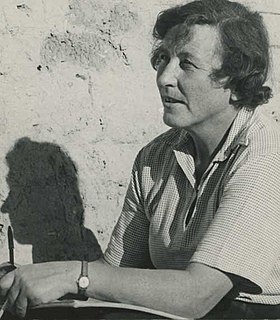
Dame Kathleen Mary Kenyon, was a British archaeologist of Neolithic culture in the Fertile Crescent. She led excavations of Tell es-Sultan, the site of ancient Jericho, from 1952 to 1958, and has been called one of the most influential archaeologists of the 20th century. She was Principal of St Hugh's College, Oxford from 1962 to 1973 and studied herself at Somerville College, Oxford.

The Levant is an approximate historical geographical term referring to a large area in the Eastern Mediterranean region of Western Asia. In its narrowest sense, it is equivalent to the historical region of Syria, which included present-day Syria, Lebanon, Jordan, Israel, Palestine and most of Turkey south-east of the middle Euphrates. In its widest historical sense, the Levant included all of the Eastern Mediterranean with its islands; that is, it included all of the countries along the Eastern Mediterranean shores, extending from Greece to Cyrenaica in eastern Libya.

Samaria is a historical and biblical name used for the central region of the ancient Land of Israel, bordered by Galilee to the north and Judaea to the south. For the beginning of the Common Era, Josephus set the Mediterranean Sea as its limit to the west, and the Jordan River as its limit to the east. Its territory largely corresponds to the biblical allotments of the tribe of Ephraim and the western half of Manasseh; after the death of Solomon and the splitting-up of his empire into the southern Kingdom of Judah and the northern Kingdom of Israel, this territory constituted the southern part of the Kingdom of Israel. The border between Samaria and Judea is set at the latitude of Ramallah.
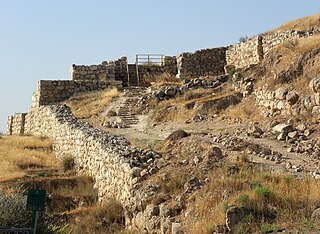
Tel Lachish, known in Arabic as Tell ed-Duweir, is the site of an ancient Near Eastern city, now an archaeological site and an Israeli national park. The park was established on lands of the depopulated Palestinian village of Qobebet Ibn ‘Awwad.

William Foxwell Albright was an American archaeologist, biblical scholar, philologist, and expert on ceramics.

Biblical archaeology is an academic school and a subset of Biblical studies and Levantine archaeology. Biblical archaeology studies archaeological sites from the Ancient Near East and especially the Holy Land, from biblical times.

Tell el-Hesi, or Tell el-Hesy, is a 25-acre archaeological site in Israel. It was the first major site excavated in Palestine, first by Flinders Petrie in 1890 and later by Frederick Jones Bliss in 1891 and 1892, both sponsored by the Palestine Exploration Fund (PEF). Petrie's excavations were one of the first to systematically use stratigraphy and seriation to produce a chronology of the site. Tell el-Hesi is located southwest of the modern Israeli city of Qiryat Gat.

Ghassulian refers to a culture and an archaeological stage dating to the Middle and Late Chalcolithic Period in the Southern Levant. Its type-site, Teleilat Ghassul, is located in the eastern Jordan Valley near the northern edge of the Dead Sea, in modern Jordan. It was excavated in 1929-1938 and in 1959–1960, by the Jesuits. Basil Hennessy dug at the site in 1967 and in 1975–1977, and Stephen Bourke in 1994–1999.
The prehistory of the Levant includes the various cultural changes that occurred, as revealed by archaeological evidence, prior to recorded traditions in the area of the Levant. Archaeological evidence suggests that Homo sapiens and other hominid species originated in Africa and that one of the routes taken to colonize Eurasia was through the Sinai Peninsula desert and the Levant, which means that this is one of the most important and most occupied locations in the history of the Earth. Not only have many cultures and traditions of humans lived here, but also many species of the genus Homo. In addition, this region is one of the centers for the development of agriculture.
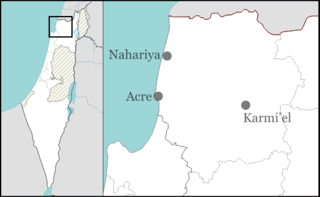
Bi'ina or al-Bi'na is an Arab town in the Northern District of Israel. It is located east of Akko. In 2003, Bi'ina merged with Majd al-Krum and Deir al-Asad to form the city of Shaghur, but was reinstated as a local council in 2008 after Shaghur was dissolved. Bi'ina has a mostly Muslim population (92%) with a small Christian minority (8%); in 2019 its population was 8,381.
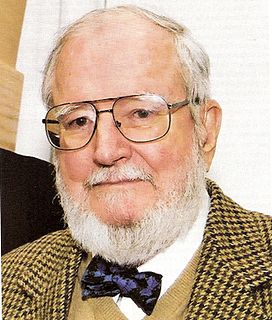
Frank Moore Cross Jr. (1921–2012) was the Hancock Professor of Hebrew and Other Oriental Languages Emeritus at Harvard University, notable for his work in the interpretation of the Dead Sea Scrolls, his 1973 magnum opusCanaanite Myth and Hebrew Epic, and his work in Northwest Semitic epigraphy. Many of his essays on the latter topic have since been collected in Leaves from an Epigrapher's Notebook.
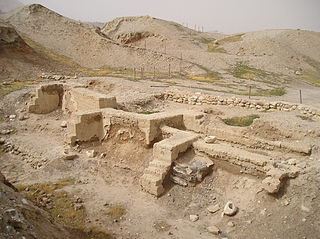
Levantine archaeology is the archaeological study of the Levant. It is also known as Syro-Palestinian archaeology or Palestinian archaeology. Current archaeological digs are carried out by the Israel Antiquities Authority (IAA), or else the Palestinian Authority's (PA) Ministry of Tourism and Antiquity, working under the auspices of the IAA. Besides its importance to the discipline of Biblical archaeology, the Levant is highly important when forming an understanding of the history of the earliest peoples of the Stone Age. The Palestinian Authority prohibits unrestricted excavation at sites of archaeological importance.

Biblical archaeology, occasionally known as Palestinology is the school of archaeology which concerns itself with the biblical world.

Yosef Garfinkel is a professor of Prehistoric Archaeology and of Archaeology of the Biblical Period at the Hebrew University of Jerusalem.

The W. F. Albright Institute of Archaeological Research (AIAR), is an archaeological research institution located in East Jerusalem. It is the oldest American research center for ancient Near Eastern studies in the Middle East. Founded in 1900 as the American School of Oriental Research, it was renamed in 1970 after its most distinguished director and the father of Biblical archaeology, William F. Albright. Its mission is to develop and disseminate scholarly knowledge of the literature, history, and culture of the Near East, as well as the study of civilization from pre-history to the early Islamic period.
The Kenyon Institute, previously known as the British School of Archaeology in Jerusalem (BSAJ), is a British overseas research institute supporting humanities and social science studies in Israel and Palestine. It is part of the Council for British Research in the Levant and is sponsored by the British Academy.
The Tahunian is variously referred to as an archaeological culture, flint industry and period of the Palestinian Stone Age around Wadi Tahuna near Bethlehem. It was discovered and termed by Denis Buzy during excavations in 1928.
Denis Buzy was a French archaeologist who excavated the Tahunian culture at Wadi Tahuna near Bethlehem in 1928.
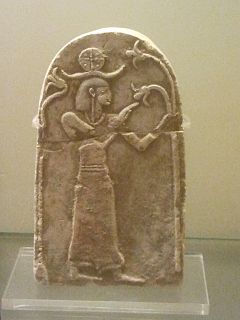
Tell Beit Mirsim is an archaeological site in Israel, on the border between the Shfela and Mount Hebron.
Beth-Anath was mentioned in the Bible Book of Joshua and the Book of Judges as a land given to Naphtali.
References
- ↑ Avi Gopher (November 1994). Arrowheads of the neolithic Levant: a seriation analysis. Eisenbrauns. pp. 12–. ISBN 978-0-931464-76-8 . Retrieved 11 January 2012.
- ↑ Buzy, Denis., Une Industrie Mesolithique en Palestine, In : Revue biblique, ISSN 0035-0907, vol.37 1 4, pp. 558–578, Planches XXVII-XXXI, 1928.
- ↑ Moore, A.M.T. (1978). The Neolithic of the Levant, Neolithic Palestinian Tahunian. Oxford University, Unpublished Ph.D. Thesis. pp. Selected Excerpt on the Tahunian Period.
- ↑ Albright, W. F., Recent progress in the late prehistory of Palestine WF Albright - Bulletin of the American Schools of Oriental Research, 1931.
- ↑ Banning, E.B., The Neolithic period: Triumphs of architecture, agriculture, and art, Near Eastern Archaeology, American schools of Oriental Research, 1998.
- ↑ Braidwood, L., Notes on the Flint Implements of Tabbat Al-Hammām, Institut Francais du Proche-Orient, Syria, 1940
- ↑ Wendell Stephen Reilly; Catholic Biblical Association of America (1964). The Catholic Biblical quarterly. Catholic Biblical Association of America. Retrieved 5 September 2012.
| This article about the region of Palestine is a stub. You can help Wikipedia by expanding it. |
| This article relating to archaeology in the Near East is a stub. You can help Wikipedia by expanding it. |